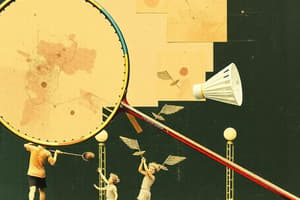Podcast
Questions and Answers
What is the main purpose of activities 1.3 and 1.4 in badminton training?
What is the main purpose of activities 1.3 and 1.4 in badminton training?
- To engage in competitive games (correct)
- To improve footwork
- To focus on grip techniques
- To practice serving techniques
Which technique involves gripping the middle of the handle and forming a V shape to the nondominant side of the handle?
Which technique involves gripping the middle of the handle and forming a V shape to the nondominant side of the handle?
- Serving grip
- Forehand grip (correct)
- Backhand grip
- Clearing technique
What is the key point emphasized in the backhand grip technique?
What is the key point emphasized in the backhand grip technique?
- Gripping at the top of the handle (correct)
- Aligning index finger and thumb
- Contacting the bottom edge of the racket
- Keeping the palm relaxed
What is the correct posture for forehand serving in badminton?
What is the correct posture for forehand serving in badminton?
What is the primary focus of rear court footwork in badminton?
What is the primary focus of rear court footwork in badminton?
What is the purpose of engaging in multishuttle activity during badminton training?
What is the purpose of engaging in multishuttle activity during badminton training?
What is the correct posture for holding the shuttle when preparing for a forehand serve in badminton?
What is the correct posture for holding the shuttle when preparing for a forehand serve in badminton?
What is the recommended foot positioning for the non-dominant foot when preparing for a forehand serve in badminton?
What is the recommended foot positioning for the non-dominant foot when preparing for a forehand serve in badminton?
What should the wrist position be during a forehand serve in badminton?
What should the wrist position be during a forehand serve in badminton?
What should the racquet hand position be at during a forehand serve in badminton?
What should the racquet hand position be at during a forehand serve in badminton?
What is the recommended angle for the racquet head during a forehand serve in badminton?
What is the recommended angle for the racquet head during a forehand serve in badminton?
What should the non-dominant arm be doing during a forehand serve in badminton?
What should the non-dominant arm be doing during a forehand serve in badminton?
When should the point of contact occur during a forehand serve in badminton?
When should the point of contact occur during a forehand serve in badminton?
What should the palm be doing after serving during a forehand serve in badminton?
What should the palm be doing after serving during a forehand serve in badminton?
What is the recommended movement after completing a forehand serve in badminton?
What is the recommended movement after completing a forehand serve in badminton?
During which frame of motion does the racquet arm point upwards and both non-dominant hand and dominant arm are up in badminton?
During which frame of motion does the racquet arm point upwards and both non-dominant hand and dominant arm are up in badminton?
Flashcards are hidden until you start studying
Study Notes
Badminton Training
- Activities 1.3 and 1.4 are focused on improving footwork and basic strokes.
- The V grip technique involves gripping the middle of the handle and forming a V shape to the non-dominant side of the handle.
- The key point in the backhand grip technique is to keep the thumb and index finger on top of the handle.
- For forehand serving, maintain a correct posture with feet shoulder-width apart, with the body weight evenly distributed between both feet.
- The primary focus of rear court footwork is to move quickly and efficiently around the court while maintaining balance and control.
- Multishuttle activity during training aims to improve reaction time, agility, and overall court speed.
- When preparing for a forehand serve, hold the shuttle with the thumb and index finger, with the shuttle lying flat on the palm.
- Position the non-dominant foot forward and slightly to the right (for right-handers), with the dominant foot back and slightly to the left.
- During a forehand serve, keep the wrist firm and in a neutral position.
- The racquet hand position should be at a 90-degree angle to the forearm, with the racquet head pointing downwards.
- The racquet head should be angled at 10-12 o'clock during a forehand serve.
- The non-dominant arm should be extended and relaxed, providing balance and stability.
- The point of contact for the forehand serve should occur at the highest point of the toss, around 6-8 feet in the air.
- After serving, the palm should rotate downwards, with the racquet falling back to the ready position.
- After completing a forehand serve, move backwards and to the left (for right-handers) to get back into position.
- During the "loading" frame of motion, the racquet arm points upwards, and both the non-dominant hand and dominant arm are up.
Studying That Suits You
Use AI to generate personalized quizzes and flashcards to suit your learning preferences.




